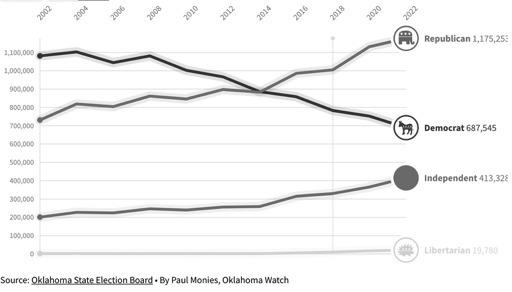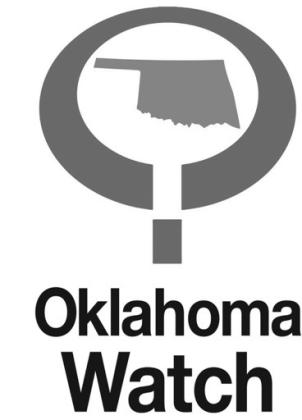It’s been 20 years since Democrat Brad Henry won the Oklahoma gubernatorial election, and the changes in party registration since then show how much the Republican Party has made inroads into traditionally “yellowdog” Democrat rural areas.
Rural counties are the battleground in this year’s governor’s race between incumbent Republican Kevin Stitt and newly minted Democrat Joy Hofmeister, who switched parties last year after winning statewide office twice as a Republican. Libertarian Natalie Bruno and Independent Ervin Yen are also vying for the governor’s office.
The latest polls show a competitive race, largely from a barrage of negative outside advertising against Stitt since the summer and his policies on school vouchers, whicharen’tverypopular in rural areas.
Still, any Republican statewide candidate starts out with a natural advantage in Oklahoma, with 51% of voters as registered Republicans, according to the latest snapshot by the state Election Board. Democrats make up 30% of voters, with Libertarians at almost 1%.
Those party registration numbers are drastically different from 2002, when Democrats made up 54% of registered voters and Republicans were at 36%.
Despite the surge in Republican Party registration in the past two decades, the number of voters identifying as independent has grown by bigger margins.
Independents now make up 18% of registered voters in Oklahoma, according to Election Board data. That’s up from 10% in 2002. Those voters, and moderate Republicans in rural areas, will be key if Hofmeister is to make any inroads in what’s now a red wall in many of the state’s counties outside of theOklahomaCityandTulsa metropolitan areas.
Stittwonin2018with54% of the vote. He won all but four counties against Democrat Drew Edmondson, who served four terms as attorney general from 1995 to 2011.
R e p u b l i c a n R e g i s t r at i o n
I n r o a d s
Back in 2002, Democrats could count on almost similar shares of their voters being from rural and urban areas. Almost 26% of the state’s voters in 2002 were Democrats living in 14 counties now making up the metropolitan areas of Oklahoma City and Tulsa. Another 28% of voters wereregisteredDemocratsin the rest of the state.
Now, that rural share has dropped dramatically. Democrats from metro-area counties make up 19% of registered voters in the state. Democrats from the rest of the state’s counties make up just 11% of the electorate.
Republicans, meanwhile, made huge inroads in party registration in both metro counties and rural counties in the past 20 years, according to 2022 voter registration data. Republicans in the 14 metro counties make up 31% of the state’s registered voters. Registered Republicans from the other 63 counties make up 20% of the state’s voters.
Straight-party voting has been rising in recent elections, too. Almost 46% of voters chose that option in the 2020 general election, according to the state Election Board.And40%ofvoters chose straight-party voting in the 2018 general election. Presidential election years typically attract a larger turnout of voters.
With Republicans dominant in party registration, straight-party voting is another hill for any Democrat to climb in this year’s election. Oklahoma is just one of six states that allow straightticket voting, according to the National Conference of State Legislatures.
The urban-rural divide is an important one, but it’s not the only factor when it comes to elections. Turnout is key. And counties are rarely monolithic: there are bustling college towns in rural counties and five-acre homesteads in the exurban areas of populous counties. Educational attainment has become a key factor in party affiliation, according to the Pew Research Center.
Still, Oklahoma Democrats haven’t won statewide since 2006, when Henry won his second term and Edmondson won his fourth term. Oklahoma hasn’t voted for a Democrat for president since 1964. In 2020, former President Donald J. Trump, a Republican, carried every Oklahoma county. The closest was Oklahoma County, where Trump won by 1 percentage point.
Meanwhile, independents increased their share of the electorate in the last two decades, with metro independents growing to 12% of the electorate, up from 6% in 2002.Thegrowthwassimilar in rural counties, with the share of independents going to 6% in 2022 from 4% in 2002.
The state has about 300,000 more registered voters than it did in 2002, which is in line with population increases in the past 20 years. Almost all of that population growth has come in the Oklahoma City and Tulsa metropolitan areas.
In 2022, there were about 875,000 voters in the 63 counties outside of the 14-county metro areas of Oklahoma City and Tulsa. That compares to about 871,000 voters inthoseareasin2002,according to Election Board data.
Paul Monies has been a reporter with Oklahoma Watch since 2017 and covers state agencies and public health. Contact him at (571) 319-3289 or pmonies@oklahomawatch. org. Follow him on Twitter @pmonies.
Oklahoma Watch, at oklahomawatch. org, is a nonprofit, nonpartisan news organization that covers public-policy issues facing the state.


